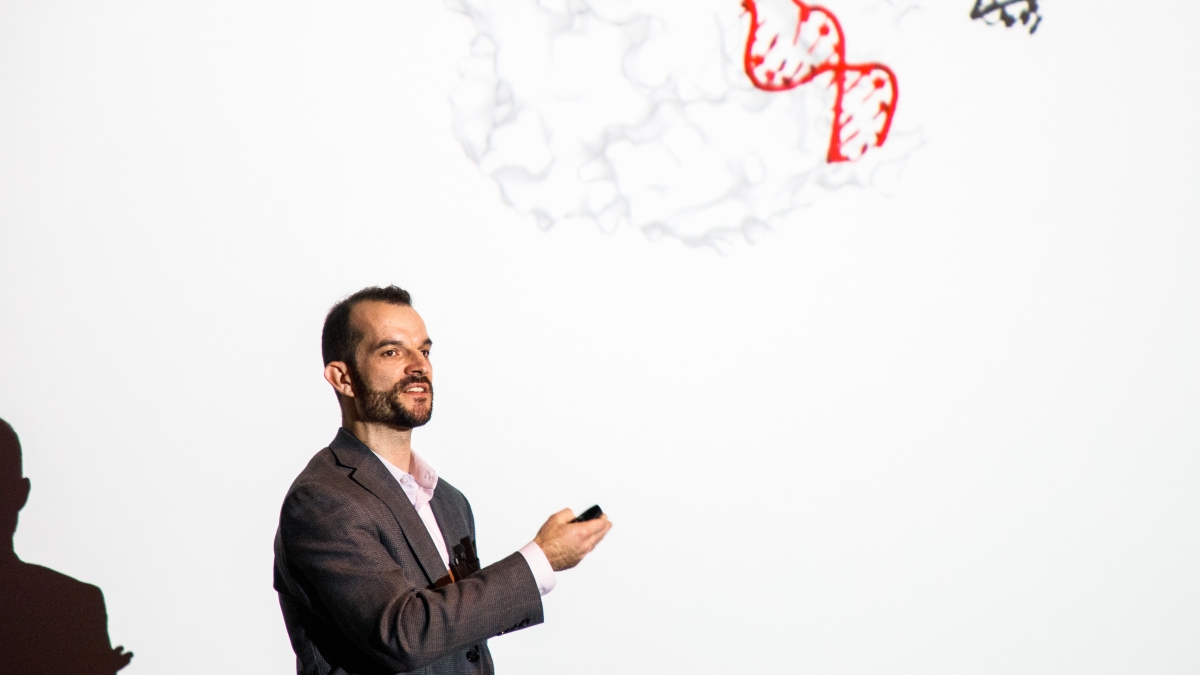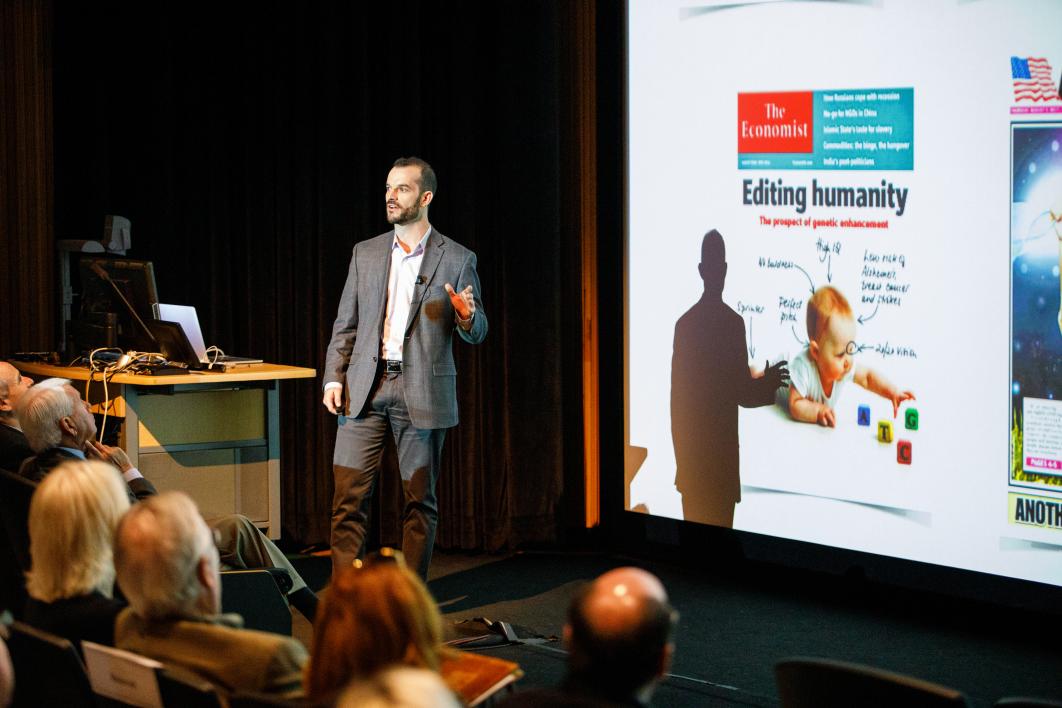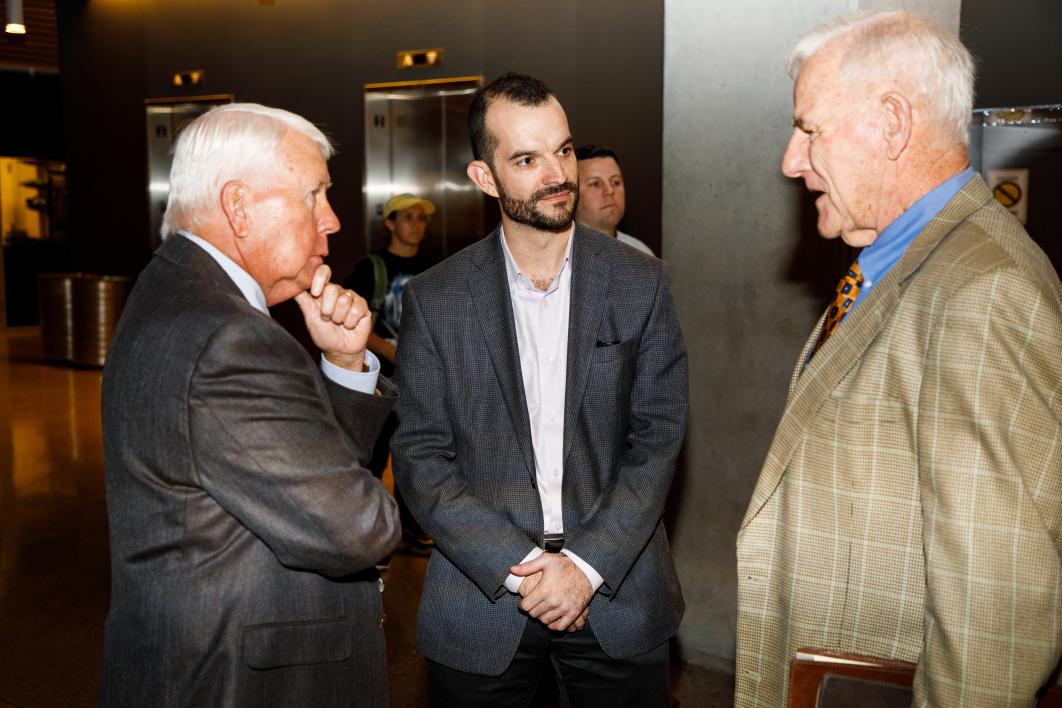Expert shares advances and opportunities for genetic editing

Samuel Sternberg is an assistant professor at Columbia University’s Department of Biochemistry and Molecular Biophysics where he heads a research lab. He is also the co-author of "A Crack in Creation: Gene Editing and the Unthinkable Power to Control Evolution." Photo by Andy DeLisle
Genome engineering was the subject of the day as Arizona State University’s Biodesign Institute kicked off a new lecture series designed to bring science’s preeminent thought leaders to ASU. The Arntzen Grand Challenges Lecture Series launched on Nov. 1 with a presentation by Samuel Sternberg, co-author of "A Crack in Creation: Gene Editing and the Unthinkable Power to Control Evolution" — the premiere text on the emergence and future of genetic editing.
CRISPR is a revolutionary tool used by scientists to quickly and cost-effectively make precise changes to eukaryotic cells. Scientists program RNA to signal to a Cas9 protein to make cuts in corresponding DNA sequences, thereby creating new changes in the DNA when it repairs itself.
“I think we’re really going to see some remarkable advances over the next five to 10 years on harnessing the power of gene editors for medicine,” Sternberg said. “I think there's a lot of exciting ongoing research by people here at ASU and elsewhere to really better understand how to navigate some of the ongoing limitations.” Sternberg addressed an audience of nearly 200 scholars, students and faculty for the duration of his “Programmable Genome Engineering Using CRISPR Technology” lecture. During his visit he also met and held small group discussions with ASU students working in related fields.
The lecture series is named for the Biodesign Institute’s founding director, Charles (Charlie) Arntzen, and serves to acknowledge the example he set for future generations of scientists.
“Charlie Arntzen has always encouraged us to think big, think together and think ahead,” said Joshua LaBaer, executive director of the Biodesign Institute. “With the launch of the Arntzen Grand Challenges Lecture Series, his passion for students, science and discovery comes alive. I can think of no better way to inspire others to adopt Charlie’s pursuit of creative thinking than to bring some of the world’s brightest minds to ASU.”
“Sam Sternberg was part of the team that discovered gene editing technology,” Arntzen said of his choice for the inaugural speaker for the series. “He is an international spokesperson for the power of CRISPR-Cas9 in medical advancements. But he also devotes energy to public discussion of the societal implications of this transformative technology.”
Sternberg delivered a lecture to nearly 200 attendees interested in genomic editing and the big questions facing science and humanity. Photo by Andy DeLisle
ASU research related to genetic editing
“We need to understand the power of this technology. It can lead to changes in the human genome and within years, the reach can be limitless. Education, awareness and engagement of the public is a key,” said Samira Kiani, an ASU researcher and assistant professor in the School of Biological and Health Systems Engineering in the Ira A. Fulton Schools of Engineering. Providing a platform for discussion, Kiani is producing “Code of the Wild,” a documentary which will be released next year.
“My focus is to generate synthetic genetic tools for safety and controllability of gene editing therapies. We develop technologies to address when, where and how genes are modified by CRISPR, a revolutionary system for gene editing,” Kiani said.
Her lab, in collaboration with Jin Park, an assistant research professor at the Biodesign Virginia G. Piper Center for Personalized Diagnostics, recently received one of the first NIH grants for CRISPR research in somatic cells. In particular, her team deals with safety concerns, such as avoiding undesirable immune reactions and limiting the extent of changes to the intended target, sparing other recipients.
Park’s other research, co-led with LaBaer at the Biodesign Institute, investigates the mechanisms of breast cancer progression. Using gene-editing technology to generate artificial mutations, their team tests the contributions of breast epithelial cells to the cancer development process. According to Park, the eventual goal is to develop a screening method to identify drug targets for personalized treatment of cancer.
Big questions prevail: Access, affordability, ethics
During the question and answer period, Jacques Sokolov, chairman of the board of Phoenix Children’s Hospital and chair of ASU’s Health Futures Council, told the audience that Phoenix Children’s Hospital is at the leading edge with treating young patients with cancer via individualized CRISPR treatments. He expressed concern for high financial costs, leading to lack of accessibility.
Ethical questions have closely followed CRISPR’s discovery — ranging from equity of access and affordability to responsible usage.
Sternberg brought up the possibility of gene drives spreading CRISPR-influenced genes into the general population very quickly. Typically in nature, unusual or mutated genes are diluted in reproduction over time. However, with CRISPR technology the genes selected could be passed into new generations in a widespread and dominant manner.
In some cases, gene drives could be used for the benefit of humanity. For the approximately 215 million people clinically affected by malaria each year, breeding mosquitos to be resistant to the disease could save countless lives. Scientists must still proceed with caution, as unforeseen consequences could arise. Sternberg advised taking a careful approach prior to enacting and regulating potentially irreversible changes to wild populations.
Charles Arntzen (left), founding director of ASU’s Biodesign Institute, is internationally recognized for his development of genetic strategies for producing pharmaceuticals from plants. The Arntzen Grand Challenges Lecture Series serves to inspire future scientists. After an intellectually exhilarating hour, the conversation between Sternberg, Arntzen and others continued. Photo by Andy DeLisle
Arntzen Auditorium Legacy Fund established at ASU Foundation
The annual lecture series allows both scientists and the general public to benefit from the brilliance of visiting minds, who can offer fresh insights to the ASU community. It is hoped such events will also foster future research partnerships and stimulate exchanges of ideas with distinguished scientists and scholars like Sternberg.
Some of Arntzen’s notable accomplishments include cultivating plant-based pharmaceuticals to treat Ebola infections, as well as serving on the President’s Council of Advisors on Science and Technology for George W. Bush, and being inducted to the U.S. National Academy of Science.
Arntzen and his wife, Kathy, have committed $100,000 towards establishing the Arntzen Auditorium Legacy Fund. The university is actively seeking $550,000 in philanthropic contributions. Gifts will be used to establish a permanent endowment that will fund the annual visiting lectureship from a world-renowned scientific leader who will spend time in partnership with ASU scientists, engaging with students, and sharing recent findings with the community at large.
The next lecture in the series will take place in early November 2019. Further details to be announced.
More Science and technology

Compact X-ray laser lab aims to reveal deep secrets of life, matter and energy
X-rays allow us to view inside the human body to diagnose broken bones and other hidden problems. More recent X-ray advances are…

Apollo lunar samples enable ASU researcher to pinpoint moon’s crystallization timeline
A team of researchers, including Arizona State University geochemist Melanie Barboni, in collaboration with scientists from The…

NASA launches space telescope to chart the sky and millions of galaxies
California’s Vandenberg Space Force Base was the site for Tuesday’s 8:10 p.m. launch of the NASA SPHEREx mission aboard a SpaceX…



